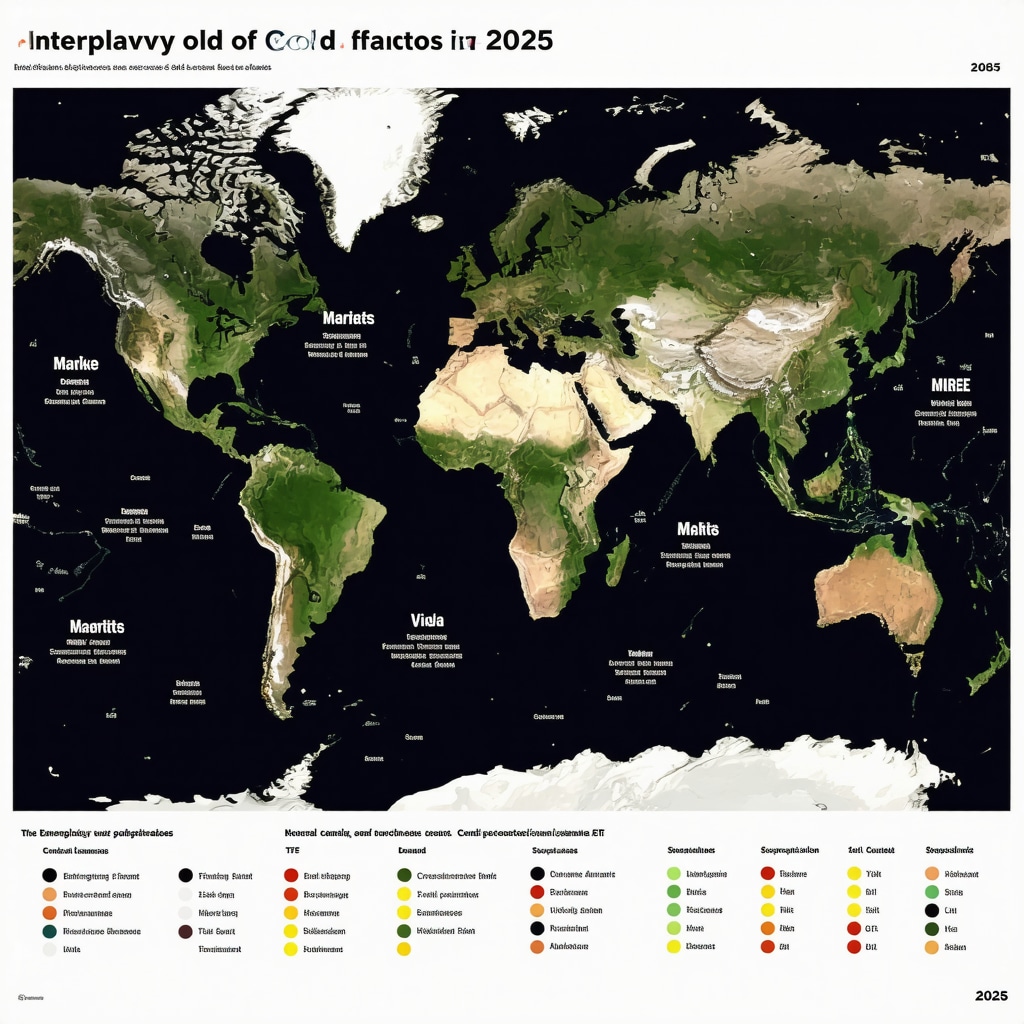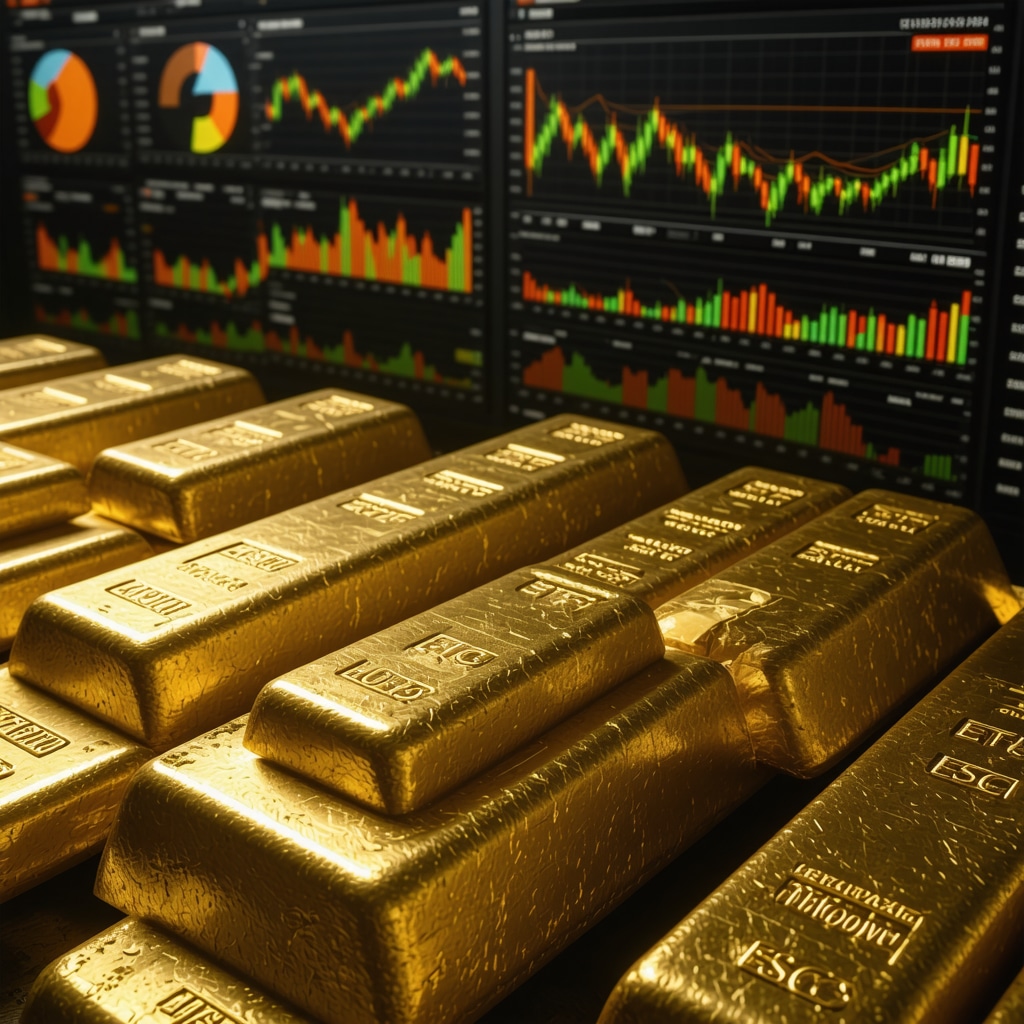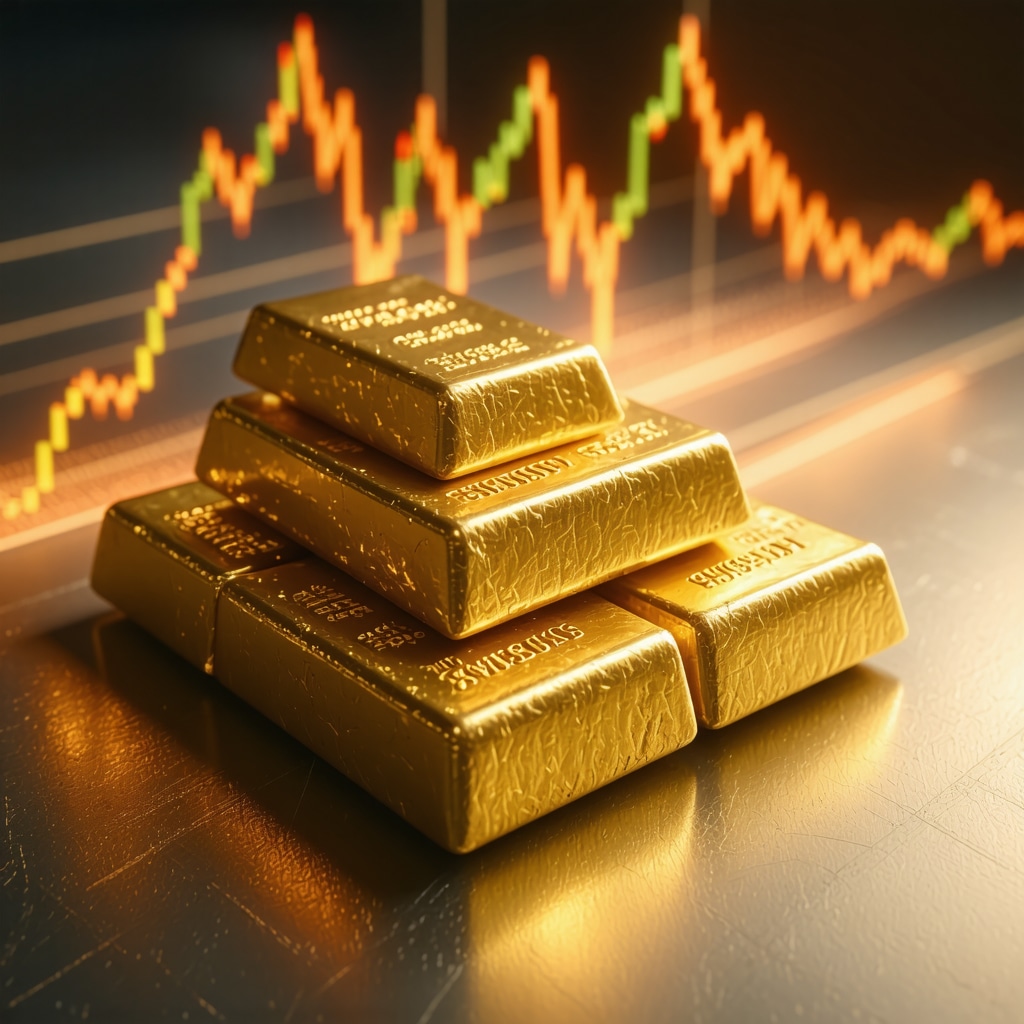Unlocking the Complex Dance Between Gold Demand and Price Predictions for 2025
As global economies navigate volatility, understanding how gold demand trends influence price forecasts in 2025 is more critical than ever for investors and analysts alike. Gold is not just a commodity; it’s a barometer of economic confidence, inflation fears, and geopolitical tensions. This article delves into the nuanced dynamics driving gold demand, revealing how shifts in consumer behavior, central bank policies, and emerging markets collectively shape the gold price outlook for the coming year.
Emerging Market Appetite: The Silent Force Behind Gold Prices
Emerging markets, particularly in Asia, continue to bolster global gold demand through both investment and jewelry consumption. Countries like India and China remain pivotal, with cultural affinity for gold driving persistent buying even amid economic headwinds. For example, India’s festival season traditionally spikes jewelry demand, adding seasonal upward pressure on prices. Meanwhile, rising middle-class wealth in these regions introduces new investment buyers, often seeking gold as a hedge against local currency depreciation.
How Do Central Bank Gold Purchases Affect Price Trends in 2025?
Central banks have become strategic players in the gold market, with increased reserves signaling confidence in gold’s role as a safe-haven asset. In 2024, many central banks, including Russia and Turkey, ramped up acquisitions to diversify reserves away from fiat currencies. This trend is anticipated to persist in 2025, creating a firm floor for gold prices. Such purchases reduce available supply on the open market, which, combined with geopolitical uncertainties, can amplify price volatility and upward momentum. According to the World Gold Council, central bank buying played a significant role in supporting gold prices during economic instability periods (World Gold Council – Central Bank Gold Purchasing Trends).
Investment Demand: ETFs and Futures as Market Movers
Investment demand through gold ETFs and futures contracts continues to be a major price driver. In times of inflationary pressure or stock market uncertainty, investors flock to these instruments for liquidity and portfolio diversification. The growing sophistication of trading algorithms and global market integration means shifts in ETF inflows can trigger significant price swings. Understanding these patterns is crucial for accurate forecasting. For those looking to deepen their grasp on ETF influences, the guide on how to analyze gold demand trends for smarter investing offers valuable insights.
Jewelry and Industrial Demand: More Than Just Ornamentation
While investment demand often steals the spotlight, jewelry and industrial uses remain substantial components of gold consumption. Innovations in electronics and medical devices have sustained steady industrial demand, subtly supporting prices. Meanwhile, shifts in consumer preferences toward sustainable and ethically sourced gold could reshape demand patterns, influencing premiums and market pricing structures.
Global Economic Uncertainties: The Ever-Present Wild Card
Economic indicators such as inflation rates, interest rate policies, and currency fluctuations profoundly affect gold demand. For instance, rising inflation typically elevates gold’s appeal as a store of value, while interest rate hikes may dampen it. The unpredictable nature of geopolitical events adds another layer of complexity, making precise forecasts challenging but essential for strategic investment planning.
Engage with Us: Share Your Thoughts on Gold Demand’s Impact in 2025
How do you anticipate gold demand trends will shape your investment strategy next year? Share your insights or questions in the comments below and join a community committed to mastering the evolving gold market. For a broader understanding, explore our comprehensive analysis on understanding global gold demand trends for smart investing.
Decoding the Impact of Technological Innovations on Gold Demand
Technological advancements continue to reshape the demand landscape for gold beyond traditional sectors. For instance, the expansion of green technologies, including solar panels and electric vehicles, relies increasingly on gold’s superior conductive properties. This emerging industrial demand segment, although smaller compared to jewelry and investment, introduces a new variable influencing price dynamics. The integration of gold in next-generation electronics enhances its strategic value, potentially tightening supply as industrial consumption grows alongside investment needs.
Geopolitical Tensions as Catalysts for Gold Market Volatility
Heightened geopolitical risks tend to elevate gold’s status as a safe haven. In 2025, ongoing conflicts and diplomatic uncertainties could accelerate capital flows toward gold assets, intensifying price volatility. Investors often respond to such tensions by reallocating portfolios toward physical gold and gold-backed securities, seeking refuge from currency fluctuations and market instability. This behavior underscores the importance of monitoring geopolitical developments closely when forecasting gold prices.
What Are the Nuances of Gold Demand in Emerging Asian Markets for 2025?
Emerging Asian markets, particularly India, China, and Southeast Asia, exhibit complex demand drivers that extend beyond cultural affinity. Urbanization and digital financial inclusion have empowered a broader investor base, altering traditional buying patterns. For example, while India’s rural regions sustain jewelry demand, urban investors increasingly favor gold ETFs and digital gold platforms for liquidity and convenience. Additionally, regulatory changes and import duties in these countries influence market accessibility and pricing structures. Understanding these nuances is essential for precise demand forecasting and strategic investment positioning.
For those interested in the deeper mechanics of gold demand in emerging markets, the article on gold demand trends in emerging markets offers a comprehensive examination of these factors.
Central Banks’ Strategic Reserve Management: A Key Price Factor
Central banks’ gold reserve strategies are evolving with a focus on long-term stability and diversification. Beyond accumulation, some central banks are engaging in gold lending and swaps to optimize reserve portfolios without liquidating holdings. This nuanced approach affects supply-side dynamics and can dampen or amplify price movements depending on macroeconomic conditions. Investors who track central bank policies gain an edge in anticipating market shifts.
Exploring the Role of Gold Futures and ETFs in Price Discovery
Gold futures and ETFs serve as essential instruments for price discovery and liquidity. The interplay between these derivatives and physical demand forms a complex feedback loop influencing spot prices. Market participants leverage futures contracts to hedge or speculate, which can cause short-term price distortions. Meanwhile, ETFs provide accessible exposure to gold, often attracting retail investors during times of heightened uncertainty. Understanding these instruments’ market mechanics is crucial for sophisticated forecasting models and risk management.
For detailed strategies on leveraging gold ETFs, see how to select top gold ETFs and mutual funds for growth.
How Do Seasonal and Cultural Cycles Influence Gold Demand Patterns?
Seasonal events like weddings and festivals, especially in South Asia, create predictable spikes in gold demand. These cultural cycles can temporarily elevate prices, affecting short-term market sentiment. Investors and traders who incorporate these temporal factors into their analysis can better time entry and exit points. Furthermore, shifts in consumer behavior due to changing social dynamics, such as younger generations’ preferences for digital gold, introduce new complexities in demand seasonality.
Engage and Expand: Your Expertise on Gold Market Dynamics
How do you integrate emerging market behaviors, technology-driven demand, and geopolitical factors into your gold investment strategies for 2025? Share your advanced insights or questions below to foster a knowledgeable community dedicated to mastering the complexities of gold markets. For more expert-level analysis, explore our in-depth coverage on gold market analysis and key price drivers.

Behavioral Economics in Gold Investment: Decoding Investor Psychology’s Impact on Demand and Price
Investor psychology, often overlooked, plays a pivotal role in shaping gold demand and price trajectories. Behavioral economics reveals that cognitive biases such as loss aversion, herd behavior, and overconfidence significantly influence buying patterns. For example, during periods of market stress, investors’ fear-driven rush to gold can create demand surges disproportionate to fundamentals, causing price overshoots. Conversely, complacency during bullish equity markets may suppress gold interest despite underlying inflationary pressures.
Advanced models incorporating sentiment indices derived from social media analytics and market news flow provide enhanced forecasting capabilities. These tools help identify inflection points where sentiment-driven demand could trigger price reversals or rallies. Understanding these psychological undercurrents offers a competitive edge in anticipating gold market moves beyond traditional supply-demand metrics.
Integrating Macro-Financial Indicators: A Multi-Layered Approach to Gold Price Forecasting
Gold price forecasts for 2025 increasingly rely on synthesizing complex macro-financial indicators, including real interest rates, currency strength, and inflation expectations. Real yields, defined as nominal yields minus inflation, inversely correlate with gold prices; as real yields fall below zero, gold’s opportunity cost declines, boosting demand. Additionally, the US dollar’s trajectory markedly influences gold pricing since the metal is dollar-denominated. Currency depreciation in major economies often propels gold demand as a hedge against currency risk.
Moreover, inflation expectations, gleaned from breakeven inflation rates in bond markets, serve as leading indicators for gold demand shifts. Sophisticated econometric models now integrate these variables to produce probabilistic price forecasts, accommodating volatility and structural breaks in market behavior.
How Can Real-Time Data Analytics Enhance Gold Demand Forecasting Models?
The incorporation of real-time data analytics is revolutionizing gold demand forecasting by providing granular, high-frequency insights into market dynamics. Streaming data from commodity exchanges, ETF flows, and social sentiment platforms enable immediate detection of emerging trends and anomalies. Machine learning algorithms can process this data to identify non-linear relationships and latent factors influencing demand that traditional models might miss.
For instance, sudden geopolitical events or macroeconomic announcements can cause rapid shifts in gold-related trading volumes and sentiment, which real-time analytics capture effectively, allowing for dynamic adjustment of forecasts. Implementing such advanced analytics tools is becoming indispensable for institutional investors and analysts aiming to maintain an informational edge.
Evaluating the Role of Sustainable and Ethical Gold in Shaping Future Demand
As the global investment community increasingly prioritizes Environmental, Social, and Governance (ESG) criteria, sustainable and ethical gold is emerging as a distinct demand segment. Certified responsibly sourced gold, verified through initiatives like the Responsible Jewellery Council, commands premiums and attracts ESG-conscious investors and consumers.
This trend influences supply chains, with miners adopting improved environmental practices and transparency measures. The resultant shift in demand composition impacts pricing structures, as sustainably sourced gold may trade at a premium, affecting overall market liquidity. Investors integrating ESG factors must consider these evolving dynamics when assessing gold’s long-term demand outlook.
Engage with Our Expert Analysis: Share Your Perspectives on Behavioral and ESG Trends in Gold Markets
How do you integrate behavioral economics and ESG considerations into your gold investment strategies? Join the conversation by sharing your insights or questions below, and deepen your expertise with our comprehensive resources on advanced gold investment strategies incorporating behavioral and ESG factors.

Harnessing Real-Time Data Streams for Precision in Gold Demand Forecasting
In the quest for refining gold price predictions in 2025, market experts are increasingly deploying real-time data analytics to capture the pulse of global demand with unprecedented granularity. Unlike traditional forecasting models that rely on lagging indicators, these advanced systems integrate streaming information from commodity exchanges, ETF inflows, and sentiment analysis derived from social media platforms. Such immediacy empowers investors to detect subtle shifts in market momentum triggered by geopolitical upheavals or macroeconomic announcements, enabling agile recalibration of strategies.
Moreover, machine learning algorithms process multifaceted datasets, uncovering intricate non-linear patterns and latent drivers of gold demand that escape conventional econometric frameworks. This dynamic approach not only enhances predictive accuracy but also facilitates scenario analysis under volatile conditions, a critical capability in the rapidly evolving 2025 market landscape.
Ethical Gold: Transforming Demand Through ESG Consciousness and Market Premiums
The intersection of sustainability and gold investment is reshaping demand paradigms as Environmental, Social, and Governance (ESG) principles ascend in global finance. Certified responsible gold, authenticated by rigorous standards such as those from the Responsible Jewellery Council, attracts a growing cohort of investors willing to pay premiums for traceable and ethically mined bullion. This shift incites upstream transformations within mining operations, catalyzing adoption of cleaner technologies and transparent supply chains.
Consequently, the infusion of ESG criteria introduces nuanced price dynamics, as sustainably sourced gold may exhibit constrained liquidity but enhanced valuation metrics. For portfolio managers, integrating these ethical considerations necessitates an evolved evaluation framework that balances financial returns with social responsibility.
How Do Behavioral Economics and Real-Time Analytics Synergize to Refine Gold Market Predictions?
Behavioral economics reveals that investor sentiment and cognitive biases substantially sway gold demand, often precipitating price movements divergent from fundamental valuations. When combined with real-time data analytics, these psychological insights materialize through quantifiable sentiment indices and trading volume anomalies, enabling sophisticated models to anticipate demand surges or contractions with greater fidelity.
This synergy allows analysts to identify inflection points where herd behavior or fear-driven buying may culminate in price overshoots or corrections. Consequently, deploying hybrid models that marry behavioral insights with high-frequency data enhances the robustness of gold price forecasts amidst the complexity of 2025’s economic milieu.
For a deeper exploration of these advanced forecasting methodologies, the CFA Institute’s research on behavioral finance in investment decision-making offers authoritative guidance grounded in empirical analysis.
Engage with Our Expert Insights: Elevate Your Gold Investment Strategy for 2025
Are you ready to incorporate cutting-edge real-time analytics and ESG considerations into your gold market evaluations? Share your strategies or pose advanced questions in the comments to join a discerning network of professionals committed to mastering the multifaceted drivers of gold demand and pricing. Further enrich your expertise by exploring our specialized resources on behavioral and ESG factors shaping gold investments.
Frequently Asked Questions (FAQ)
What are the main factors driving gold demand in 2025?
Gold demand in 2025 is primarily influenced by emerging market consumption, central bank reserve policies, investment instruments like ETFs and futures, technological innovations, and geopolitical tensions. Additionally, behavioral economics and ESG considerations increasingly affect investor choices, while real-time data analytics refine demand forecasting.
How do central bank gold purchases impact gold prices?
Central bank acquisitions reduce available supply and signal confidence in gold as a reserve asset, which tends to support or elevate gold prices. Their strategic reserve management, including lending and swaps, adds complexity to supply dynamics and can create price volatility, especially during economic or geopolitical uncertainty.
Why is investor psychology important in gold markets?
Investor psychology shapes demand through biases like herd behavior and loss aversion. During market stress, fear-driven buying can cause price spikes beyond fundamental values, while complacency in bullish markets can suppress gold interest. Integrating behavioral insights with real-time analytics improves forecasting accuracy.
How do emerging Asian markets uniquely influence gold demand?
Emerging Asian markets combine cultural affinity for gold with expanding urban investor bases using digital platforms and ETFs. Regulatory changes and import duties also affect accessibility and pricing. These factors create complex, evolving demand patterns critical for precise forecasting.
What role does ESG and ethical gold play in future demand?
Environmental, Social, and Governance (ESG) criteria are driving demand for certified responsible gold, which often trades at a premium. This shifts supply chain practices towards sustainability and transparency, impacting price structures and attracting ESG-conscious investors.
How do real-time data analytics enhance gold demand forecasting?
Real-time analytics provide high-frequency insights from exchanges, ETF flows, and social sentiment, enabling detection of rapid market shifts and subtle demand drivers. Machine learning uncovers complex patterns, allowing dynamic forecasts that adapt to evolving conditions.
In what ways do geopolitical tensions affect gold prices?
Geopolitical risks elevate gold’s safe-haven appeal, prompting portfolio reallocations that increase demand and price volatility. Monitoring such tensions is essential for anticipating short-term price movements and managing investment risk.
How do seasonal and cultural cycles affect gold demand?
Seasonal events, especially in South Asia, cause predictable spikes in jewelry demand, influencing short-term price fluctuations. Changing consumer preferences, like younger generations favoring digital gold, add new dimensions to seasonal demand patterns.
What is the interplay between gold futures, ETFs, and physical demand?
Gold futures and ETFs facilitate price discovery and liquidity but can introduce short-term price distortions due to hedging and speculation. Their interaction with physical demand creates a feedback loop influencing spot prices and market sentiment.
How can investors incorporate these insights into their strategies?
Investors should integrate macro-financial indicators, behavioral economics, ESG factors, and real-time data analytics to form nuanced gold demand and price forecasts. Awareness of emerging market trends, geopolitical developments, and seasonal cycles further refines timing and risk management.
Trusted External Sources
- World Gold Council (WGC): The WGC provides authoritative research on central bank gold purchasing trends, global demand statistics, and market analysis, essential for understanding supply-demand fundamentals and institutional behaviors.
- CFA Institute – Behavioral Finance Research: Offers empirical studies on investor psychology and decision-making processes, supporting advanced insights into behavioral economics applied to gold investment strategies.
- Responsible Jewellery Council (RJC): Sets standards and certifications for sustainable and ethical gold sourcing, informing the evolving ESG-driven demand segment and its impact on market premiums.
- International Monetary Fund (IMF) – Gold Reserves Data: Provides comprehensive data on central bank gold holdings and policies, crucial for analyzing reserve management strategies affecting supply-side dynamics.
- Commodity Exchange Data Providers (e.g., COMEX, LBMA): Supply real-time trading data, price discovery metrics, and ETF flow information, enabling precise, high-frequency analytics for refined forecasting models.
Conclusion
Understanding gold demand and price forecasts for 2025 requires a multifaceted approach that synthesizes emerging market behaviors, central bank strategies, investment instruments, technological innovations, and geopolitical drivers. Behavioral economics and ESG considerations add new complexity, while real-time data analytics empower more agile and accurate forecasting. As gold continues to serve as a critical hedge and strategic asset, investors and analysts who integrate these diverse factors will be best positioned to navigate the volatile landscape ahead.
We invite you to engage with these insights—share your perspectives, ask questions, and explore our expert resources to elevate your gold investment strategy in 2025 and beyond.










